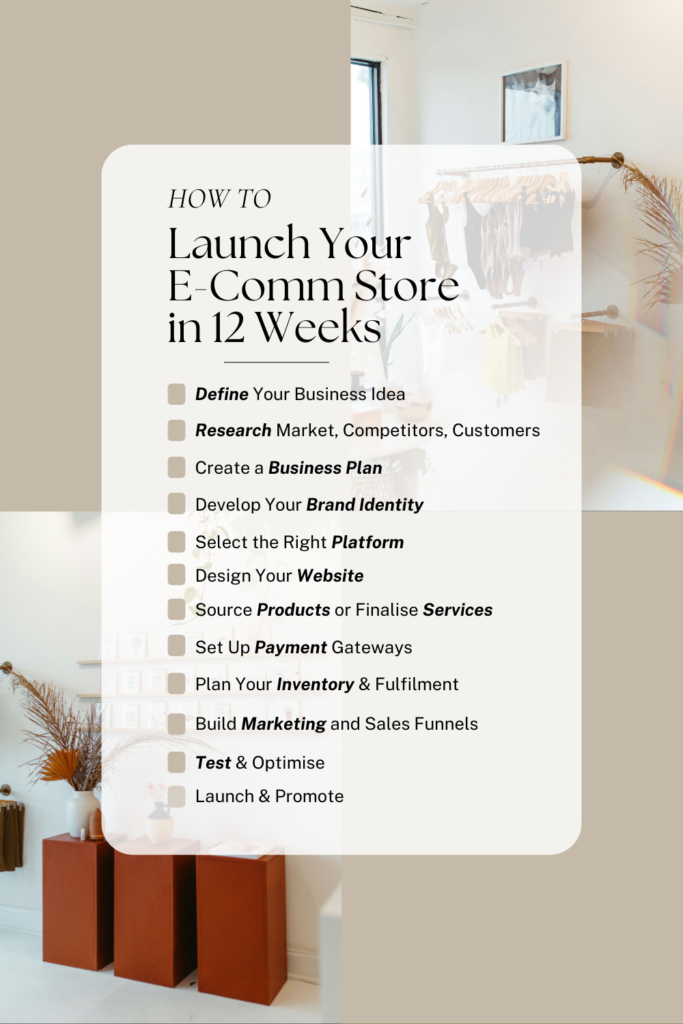How to Launch an Online Store with our 12-week Checklist
ENTREPRENEUR HUB / 24 SEPTEMBER 2024

Have you been talking about launching an online store for years but never thought you could?
Taking the first step is often the hardest part of starting a business. However, breaking your goals into manageable tasks can make the process much less daunting. With this 12-week checklist, launching your e-commerce store becomes a clear, actionable plan that helps you stay organised, execute effectively, and measure your progress every step of the way.
The digital era has opened exciting opportunities for entrepreneurs to build scalable, online businesses. Yet, the process can feel overwhelming, with new business owners often wearing multiple hats—managing everything from design and operations to finance and customer service. The secret to success lies in a solid plan. Without one, execution becomes messy and uncoordinated.
How to Launch Your E-Comm Store in 12 Weeks
By following this 12-step roadmap, you can launch your online store in just 12 weeks, transforming your concept into a full-fledged business. This checklist aims to simplify the process, helping you stay organised, complete each task, and measure your progress.
1 / Define Your Business Idea
What do you want your brand to represent?
Every successful business starts with a clear vision. Begin by defining your mission and values. Then, narrow down your niche and identify your target audience. This will help guide every decision you make, from branding to marketing.
2 / Research Market & Competitors
What is your unique selling proposition?
Understanding your market is key to finding your space in a crowded online landscape. Conduct thorough research into customer needs, pain points, and behaviours. Competitor analysis will also give you insights into pricing strategies, product offerings, and positioning—essential for carving out your unique selling point.
3 / Create a Business Plan
Where do you see this business in one year? What about in five or ten years?
A solid business plan outlines your goals, revenue model, and operational strategy. It’s not just a document for investors; it’s a blueprint for your success. Include financial projections, a timeline for growth, and plans for scaling. Having this roadmap will keep you focused and help you stay on track.
4 / Develop Your Brand Identity
Your brand is the face of your business, so it’s important to get it right. This includes designing a memorable logo, choosing your colour palette, and creating your brand’s tone of voice. These elements should resonate with your target audience and convey your core values, making your brand recognisable.
Read Next: Understanding Brand Identity: What It Is and Why Your Business Needs One
5 / Select the Right Platform
It’s important to choose the right e-commerce platform. Whether you’re considering Shopify, Squarespace, or Wix it’s essential to ensure that it meets your specific business needs and can scale for future growth. Factors such as ease of use, flexibility, and integration with other tools should be taken into consideration when making your decision.
6 / Design Your Website
Treat your website like a physical store that interacts directly with your customers. It should be user-friendly, responsive, and visually appealing. Focus on creating an intuitive customer journey, well-structured product pages, and seamless navigation. Consistency is key, so stick to the brand identity you established in week 4.
7 / Source Products + Set Your Merchandise Strategy
Now it’s time to finalise your product line or services. Whether sourcing products or creating your own, ensure your supply chain is reliable and aligns with your brand values. For service-based businesses, clearly define and package your offerings to meet market needs. This step is crucial, as it directly impacts your inventory flow, sales potential, and customer satisfaction. A well-thought-out merchandising strategy will help drive demand, maximise your profit margins, and increase customer loyalty.
Read Next: The Best Merchandising Strategies to Sell Your Products
8 / Set Up Payment Gateways
Remember to prioritise a smooth checkout process to retain customers. Integrate trusted payment gateways like PayPal, Stripe, or Afterpay, and ensure they are secure and user-friendly. Test the options yourself to understand the customer’s perspective. Additionally, remember to read the fine print regarding fees to be fully informed about the costs associated with payment tenders.
9 / Plan Your Inventory & Fulfilment
Efficient inventory management and fulfilment processes will keep your operations running smoothly. Consider whether you’ll handle fulfilment in-house or outsource it. Make sure you have the tools to track stock levels and orders, so you’re always ready to meet demand.
10 / Build Marketing + Sales Funnels
Creating and optimising marketing and sales funnels is crucial for attracting potential leads and turning them into customers. To achieve this, it’s important to craft a comprehensive content marketing strategy, establish effective email campaigns, and utilise paid advertising to increase traffic to your website. Set some guidelines and KPIs that you would like to achieve in the first eight weeks of trade and monitor them closely. The key is to concentrate on nurturing a strong connection with your audience by providing them with valuable content and personalised offers.
11 / Test & Optimise
Before going live, conduct a soft launch to ensure your website performs flawlessly. Test site speed, navigation, and the overall user experience on both desktop and mobile devices. Collect feedback from early users and review data on key metrics like page load times, conversion rates, and SEO performance. Use these insights to fine-tune your site, ensuring it’s optimised for search engines and provides a seamless, responsive experience for all visitors. The more thorough your testing, the smoother your official launch will be.
12 / Launch + Promote
Once you’re confident in your testing results, it’s time for the big reveal – launch day! Utilise your network, social media, email campaigns, and paid ads to generate buzz and attract attention to your store. Consider offering an exclusive launch promotion or partnering with influencers to further amplify your reach. Build excitement with countdowns, sneak peeks, and limited-time offers. The more anticipation you create, the more momentum your launch will gain, setting the stage for a successful debut.
How We Can Help You Launch Your E-Commerce Store
We collaborate with like-minded entrepreneurs to achieve purposeful profits through a holistic approach. If you’re gearing up to launch your e-commerce business, we offer customised services to support you through every phase of the process. Our expertise spans branding, business strategy, and marketing—helping you streamline your path from vision to launch.
Here’s how we can support your e-commerce journey:

Business Strategy + Foundations
- Vision, Values & Purpose: Clarify your business’s core.
- Revenue Stream Evaluation: Identify and maximise profit opportunities.
- Business Deep Dive + Analysis: Gain insights into performance and potential.
- Stakeholder Analysis: Understand key players to refine your approach.
Brand Development + Positioning
- Brand Identity & Positioning: Build a cohesive and compelling brand.
- Brand Strategy & Audit: Align your brand with your business goals.
- Merchandising Strategy & Optimisation: Ensure your products stand out and sell through.
- Design & Content Studio: Create impactful visuals and content.
Marketing Strategy + Growth
- Customer Segmentation & Insights: Target the right audience effectively.
- Competitor Landscape & Analysis: Stay ahead in a competitive market.
- Product/Service Launch Planning: Successfully introduce your offerings.
- Digital Marketing Roadmap: Map out a strategic marketing plan.
Entrepreneurial Mindset + Success
- Goal Setting & Mindset Coaching: Achieve your business aspirations with clarity.
- Productivity Strategies: Manage your time and resources effectively.
- Thought Leadership & Personal Branding: Position yourself as an industry leader.
- Stakeholder Management: Build and maintain key relationships.
With our strategic guidance, you can confidently launch your e-commerce store, supported by a resonating brand, a well-defined marketing strategy, and the tools for success. Schedule an initial consultation and submit your project here.






Read the Comments +